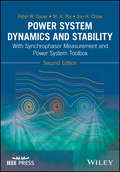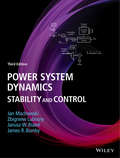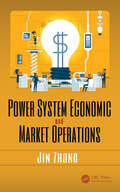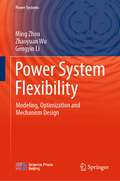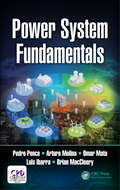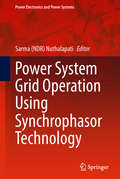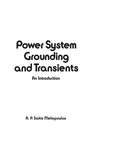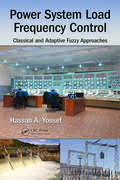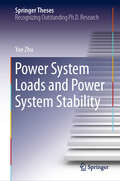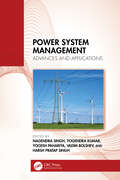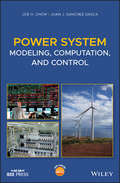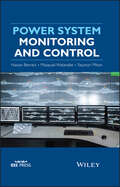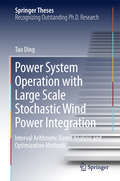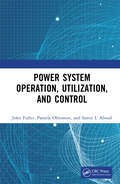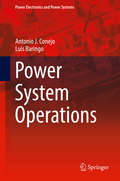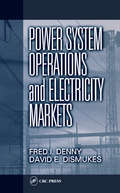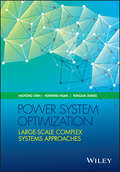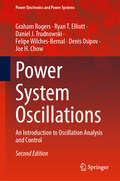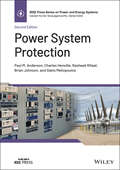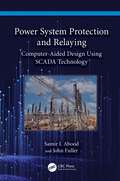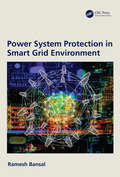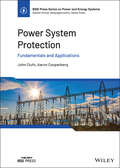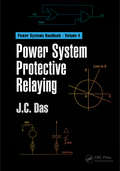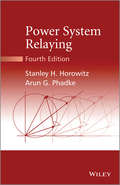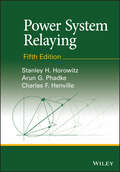- Table View
- List View
Power System Dynamics and Stability: With Synchrophasor Measurement and Power System Toolbox
by Joe H. Chow M. A. Pai Peter W. SauerClassic power system dynamics text now with phasor measurement and simulation toolbox This new edition addresses the needs of dynamic modeling and simulation relevant to power system planning, design, and operation, including a systematic derivation of synchronous machine dynamic models together with speed and voltage control subsystems. Reduced-order modeling based on integral manifolds is used as a firm basis for understanding the derivations and limitations of lower-order dynamic models. Following these developments, multi-machine model interconnected through the transmission network is formulated and simulated using numerical simulation methods. Energy function methods are discussed for direct evaluation of stability. Small-signal analysis is used for determining the electromechanical modes and mode-shapes, and for power system stabilizer design. Time-synchronized high-sampling-rate phasor measurement units (PMUs) to monitor power system disturbances have been implemented throughout North America and many other countries. In this second edition, new chapters on synchrophasor measurement and using the Power System Toolbox for dynamic simulation have been added. These new materials will reinforce power system dynamic aspects treated more analytically in the earlier chapters. Key features: Systematic derivation of synchronous machine dynamic models and simplification. Energy function methods with an emphasis on the potential energy boundary surface and the controlling unstable equilibrium point approaches. Phasor computation and synchrophasor data applications. Book companion website for instructors featuring solutions and PowerPoint files. Website for students featuring MATLABTM files. Power System Dynamics and Stability, 2nd Edition, with Synchrophasor Measurement and Power System Toolbox combines theoretical as well as practical information for use as a text for formal instruction or for reference by working engineers.
Power System Dynamics: Stability and Control
by Jan Machowski Zbigniew Lubosny Janusz W. Bialek James R. BumbyAn authoritative guide to the most up-to-date information on power system dynamics The revised third edition of Power System Dynamics and Stability contains a comprehensive, state-of-the-art review of information on the topic. The third edition continues the successful approach of the first and second editions by progressing from simplicity to complexity. It places the emphasis first on understanding the underlying physical principles before proceeding to more complex models and algorithms. The book is illustrated by a large number of diagrams and examples. The third edition of Power System Dynamics and Stability explores the influence of wind farms and virtual power plants, power plants inertia and control strategy on power system stability. The authors—noted experts on the topic—cover a range of new and expanded topics including: Wide-area monitoring and control systems. Improvement of power system stability by optimization of control systems parameters. Impact of renewable energy sources on power system dynamics. The role of power system stability in planning of power system operation and transmission network expansion. Real regulators of synchronous generators and field tests. Selectivity of power system protections at power swings in power system. Criteria for switching operations in transmission networks. Influence of automatic control of a tap changing step-up transformer on the power capability area of the generating unit. Mathematical models of power system components such as HVDC links, wind and photovoltaic power plants. Data of sample (benchmark) test systems. Power System Dynamics: Stability and Control, Third Edition is an essential resource for students of electrical engineering and for practicing engineers and researchers who need the most current information available on the topic.
Power System Economic and Market Operations
by Jin ZhongPower system operation is one of the important issues in the power industry. The book aims to provide readers with the methods and algorithms to save the total cost in electricity generation and transmission. It begins with traditional power systems and builds into the fundamentals of power system operation, economic dispatch (ED), optimal power flow (OPF), and unit commitment (UC). The book covers electricity pricing mechanisms, such as nodal pricing and zonal pricing, based on Security-Constrained ED (SCED) or SCUC. The operation of energy market and ancillary service market are also explored. "It covers a wide range of interesting topics, which could be very useful for understanding the main phenomena ruling power systems economy (such as Optimal Power Flow analysis and unit Commitments). It addresses topics widely treated in the literature, hence it is important to outline its distinctive features compared to other similar books. The book is well structured and well balanced."—Alfredo Vaccaro, University of Sannio, Italy
Power System Flexibility: Modeling, Optimization and Mechanism Design (Power Systems)
by Ming Zhou Gengyin Li Zhaoyuan WuThis book provides a detailed description of the flexibility of the power system with high share of variable renewable generation, including power system flexibility modeling, flexibility-based economic dispatch, demand side flexibility response, large-scale distributed flexible resources aggregation and market design for enhancing the flexibility of the power system, etc. The book provides an appropriate blend of theoretical background and practical applications of the power system flexibility, which are developed as working algorithms, coded in MATLAB and GAMS environments. This feature strengthens the usefulness of the book for graduate students and practitioners. Students will gain an insightful understanding of the flexibility of the power system with high share of renewables integration, including: (1) the formulation of flexibility modeling and flexibility-based economic dispatch models, (2) the familiarization with efficient solution algorithms for such models, (3) insights into these problems through the detailed analysis of numerous illustrative examples and (4) market design approach for enhancing the flexibility of the power system. Hopefully, this book greatly benefits readers in the fields of energy economics and engineering.
Power System Fundamentals
by Arturo Molina Pedro Ponce Omar Mata Luis Ibarra Brian MacCleerySmart grids are linked with smart homes and smart meters. These smart grids are the new topology for generating, distributing, and consuming energy. If these smart devices are not connected in a smart grid, then they cannot work properly; hence, the conventional power systems are swiftly changing in order to improve the quality of electrical energy. This book covers the fundamentals of power systems—which are the pillars for smart grids —with a focus on defining the smart grid with theoretical and experimental electrical concepts. <P><P> Power System Fundamentals begins by discussing electric circuits, the basic systems in smart grids, and finishes with a complete smart grid concept. The book allows the reader to build a foundation of understanding with basic and advanced exercises that run on simulation before moving to experimental results. It is intended for readers who want to comprehensively cover both the basic and advanced concepts of smart grids.
Power System Grid Operation Using Synchrophasor Technology (Power Electronics and Power Systems)
by Sarma Ndr NuthalapatiThis book brings together successful stories of deployment of synchrophasor technology in managing the power grid. The authors discuss experiences with large scale deployment of Phasor Measurement Units (PMUs) in power systems across the world, enabling readers to take this technology into control center operations and develop good operational procedures to manage the grid better, with wide area visualization tools using PMU data.
Power System Grounding and Transients: An Introduction
by A.P. Sakis Meliopoulis""This authoritative work presents detailed coverage of modern modeling and analysis techniques used in the design of electric power transmission systems -- emphasizing grounding and transients. It provides the theoretical background necessary for understanding problems related to grounding systems, such as safety and protection.
Power System Load Frequency Control: Classical and Adaptive Fuzzy Approaches
by Hassan A. YousefThis title presents a balanced blend between classical and intelligent load frequency control techniques, which is detrminant for continous supply of power loads. The classical control techniques introduced in this book include PID, pole placement, observer-based state feedback, static and dynamic output feedback controllers while the intelligent control techniques explained here are of adaptive fuzzy control types. This book will analyze and design different decentralized LF controllers in order to maintain the frequency deviations of each power area within the limits and keep the tie-line power flow between different power areas at the scheduled levels.
Power System Loads and Power System Stability (Springer Theses)
by Yue ZhuThis thesis develops a pioneering methodology and a concept for identifying critical loads and load model parameters in large power networks based on their influence on power system stability. The research described in the thesis first develops an automatic load modelling tool (ALMT) that can be used to automatically build load model from actual measured power system data without human intervention and the benefits of the ALMY are explored. Secondly, it develops a pioneering framework based on Morris screening method for ranking power system load model parameters based on their influence on overall power system stability (voltage, frequency, transient and small disturbance stability) considering different load models and loading conditions. Thirdly, a novel probabilistic methodology for determining the accuracy levels of critical load model parameters has been developed. This book will be of interest to students and researchers within the field of electrical engineering, as well as industry professionals.
Power System Management: Advances and Applications
by Nagendra Singh Yogesh Pahariya Vadim Bolshev Harsh Pratap SinghPower System Management demonstrates the effectiveness of emerging technologies in electrical systems compared to traditional operational systems. It showcases different operations of the electrical systems, presents the output results based on the latest techniques, and compares the results with classical methods. Highlights how to implement the modern automation system in the electrical transmission, and distribution systems Discusses the integration of distributed energy resources at both medium voltage (MV) and low voltage (LV) levels with modern automation systems Showcases the problems associated with the AC transmission system and the required automation control system Covers application of smart technologies including deep learning and artificial intelligence in fault detection, and grid optimization Presents real-time monitoring and control of power system devices using the Internet of Things systems, and artificial intelligence-operated robotics system used for control of electrical distribution system The text is primarily written for senior undergraduates, graduate students, and academic researchers in the fields including electrical engineering, electronics and communications engineering, computer science, and engineering.
Power System Modeling, Computation, and Control (Wiley - IEEE)
by Joe H. Chow Juan J. Sanchez-GascaProvides students with an understanding of the modeling and practice in power system stability analysis and control design, as well as the computational tools used by commercial vendors Bringing together wind, FACTS, HVDC, and several other modern elements, this book gives readers everything they need to know about power systems. It makes learning complex power system concepts, models, and dynamics simpler and more efficient while providing modern viewpoints of power system analysis. Power System Modeling, Computation, and Control provides students with a new and detailed analysis of voltage stability; a simple example illustrating the BCU method of transient stability analysis; and one of only a few derivations of the transient synchronous machine model. It offers a discussion on reactive power consumption of induction motors during start-up to illustrate the low-voltage phenomenon observed in urban load centers. Damping controller designs using power system stabilizer, HVDC systems, static var compensator, and thyristor-controlled series compensation are also examined. In addition, there are chapters covering flexible AC transmission Systems (FACTS)—including both thyristor and voltage-sourced converter technology—and wind turbine generation and modeling. Simplifies the learning of complex power system concepts, models, and dynamics Provides chapters on power flow solution, voltage stability, simulation methods, transient stability, small signal stability, synchronous machine models (steady-state and dynamic models), excitation systems, and power system stabilizer design Includes advanced analysis of voltage stability, voltage recovery during motor starts, FACTS and their operation, damping control design using various control equipment, wind turbine models, and control Contains numerous examples, tables, figures of block diagrams, MATLAB plots, and problems involving real systems Written by experienced educators whose previous books and papers are used extensively by the international scientific community Power System Modeling, Computation, and Control is an ideal textbook for graduate students of the subject, as well as for power system engineers and control design professionals.
Power System Monitoring and Control (Wiley - IEEE)
by Hassan Bevrani Masayuki Watanabe Yasunori MitaniPower System Monitoring and Control (PSMC) is becoming increasingly significant in the design, planning, and operation of modern electric power systems. In response to the existing challenge of integrating advanced metering, computation, communication, and control into appropriate levels of PSMC, Power System Monitoring and Control presents a comprehensive overview of the basic principles and key technologies for the monitoring, protection, and control of contemporary wide-area power systems. A variety of topical issues are addressed, including renewable energy sources, smart grids, wide-area stabilizing, coordinated voltage regulation, and angle oscillation damping—as well as the advantages of phasor measurement units (PMUs) and global positioning systems (GPS) time signal. End-of-chapter problems and solutions, along with case studies, add depth and clarity to all topics. Timely and important, Power System Monitoring and Control is an invaluable resource for addressing the myriad of critical technical engineering considerations in modern electric power system design and operation. • Provides an updated and comprehensive reference for researcher and engineers working on wide-area power system monitoring and control (PSMC) • Links fundamental concepts of PSMC, advanced metering and control theory/techniques, and practical engineering considerations • Covers PSMC problem understanding, design, practical aspects, and timely topics such as smart/microgrid control and coordinated voltage regulation and angle oscillation damping • Incorporates authors’ experiences teaching and researching in various international locales including Japan, Thailand, Singapore, Malaysia, Iran, and Australia
Power System Operation with Large Scale Stochastic Wind Power Integration
by Tao DingThis book addresses the uncertainties of wind power modeled as interval numbers and assesses the physical modeling and methods for interval power flow, interval economic dispatch and interval robust economic dispatch. In particular, the optimization models are set up to address these topics and the state-of-the-art methods are employed to efficiently solve the proposed models. Several standard IEEE test systems as well as real-world large-scale Polish power systems have been tested to verify the effectiveness of the proposed models and methods. These methods can be further applied to other research fields that are involved with uncertainty.
Power System Operation, Utilization, and Control
by John Fuller Samir I. Abood Pamela ObiomonThis book presents power system analysis methods that cover all aspects of power systems operation, utilization, control, and system management.At the beginning of each chapter, an introduction is given describing the objectives of the chapter. The authors have attempted to present power system parameters in a lucid, logical, step-by-step approach in a lucid, logical, step-by-step approach.In recognition of requirements by the Accreditation Board for Engineering and Technology (ABET) on integration of engineering computer tools, the authors demonstrate the use of MATLAB® programming in obtaining solutions to engineering power problems. MATLAB is introduced in a student-friendly manner and follow up is given in Appendix A. The use of MATLAB and power system applications arepresented throughout the book.Practice problems immediately follow each illustrative example. Students can follow the example step-by-step to solve the practice problems. These practice problems test students’ comprehension and reinforce key concepts before moving on to the next chapter.In each chapter, the authors discuss some application aspects of the chapter's concepts using computer programming. The material covered in the chapter applied to at least one or two practical problems to help students see how the concepts are used in real-life situations.Thoroughly worked examples are provided at the end of every section. These examples give students a solid grasp of the solutions and the confidence to solve similar problems themselves.Designed for a three-hour semester course on Power System Operation, Utilization, and Control, this book is intended as a textbook for a senior-level undergraduate student in electrical and computer engineering. The prerequisites for a course based on this book are knowledge of standard mathematics, including calculus and complex numbers and basic undergraduate engineering courses.
Power System Operations
by Antonio J. Conejo Luis BaringoThis textbook provides a detailed description of operation problems in power systems, including power system modeling, power system steady-state operations, power system state estimation, and electricity markets. The book provides an appropriate blend of theoretical background and practical applications, which are developed as working algorithms, coded in Octave (or Matlab) and GAMS environments. This feature strengthens the usefulness of the book for both students and practitioners. Students will gain an insightful understanding of current power system operation problems in engineering, including: (i) the formulation of decision-making models, (ii) the familiarization with efficient solution algorithms for such models, and (iii) insights into these problems through the detailed analysis of numerous illustrative examples. The authors use a modern, "building-block" approach to solving complex problems, making the topic accessible to students with limited background in power systems. Solved examples are used to introduce new concepts and each chapter ends with a set of exercises.
Power System Operations and Electricity Markets (Electric Power Engineering Series)
by Fred I. Denny David E. Dismukes<p>The electric power industry in the U.S. has undergone dramatic changes in recent years. Tight regulations enacted in the 1970's and then de-regulation in the 90's have transformed it from a technology-driven industry into one driven by public policy requirements and the open-access market. Now, just as the utility companies must change to ensure their survival, engineers and other professionals in the industry must acquire new skills, adopt new attitudes, and accommodate other disciplines. <p>Power System Operations and Electricity Markets provides the information engineers need to understand and meet the challenges of the new competitive environment. Integrating the business and technical aspects of the restructured power industry, it explains, clearly and succinctly, how new methods for power systems operations and energy marketing relate to public policy, regulation, economics, and engineering science. <p>The authors examine the technologies and techniques currently in use and lay the groundwork for the coming era of unbundling, open access, power marketing, self-generation, and regional transmission operations.The rapid, massive changes in the electric power industry and in the economy have rendered most books on the subject obsolete. <p>Based on the authors' years of front-line experience in the industry and in regulatory organizations, Power System Operations and Electricity Markets is current, insightful, and complete with Web links that will help readers stay up to date.</p>
Power System Optimization: Large-scale Complex Systems Approaches
by Haoyong Chen Honwing Ngan Yongjun ZhangAn original look from a microeconomic perspective for power system optimization and its application to electricity markets Presents a new and systematic viewpoint for power system optimization inspired by microeconomics and game theory A timely and important advanced reference with the fast growth of smart grids Professor Chen is a pioneer of applying experimental economics to the electricity market trading mechanism, and this work brings together the latest research A companion website is available Edit
Power System Oscillations: An Introduction to Oscillation Analysis and Control (Power Electronics and Power Systems)
by Joe H. Chow Graham Rogers Ryan T. Elliott Daniel J. Trudnowski Felipe Wilches-Bernal Denis OsipovSince the publication of the first edition of this book, wide-area measurement systems (WAMS) have transformed the way that power system oscillations are monitored and studied. These systems consist of networks of time-synchronized sensors distributed over wide geographic areas—enabling new approaches not only for situational awareness but also for power system control. This fully revised and expanded edition discusses the core ideas behind WAMS, real-time situational awareness, and wide-area control as they pertain to power system oscillations. Major technological advancements since the first edition's release are covered in five new chapters. This new material highlights a first-of-its-kind demonstration project in which a 3.1 GW high-voltage direct current transmission line was used to damp inter-area oscillations in a large interconnection. It also discusses oscillations in systems dominated by inverter-based generation, including forced oscillations, which arise not from resonances but exogenous system inputs. The book includes many worked examples throughout the text using the Power System Toolbox with MATLAB, allowing readers to analyze and/or reproduce every example independently. Power System Oscillations, Second Edition, will be a valuable reference for practicing power system engineers working in the electric utility industry. Professors, students, and research scientists studying power system dynamics will also find it to be a welcomed reference text.
Power System Protection (IEEE Press Series on Power and Energy Systems)
by Brian Johnson Paul M. Anderson Sakis Meliopoulos Charles Henville Rasheek RifaatA newly updated guide to the protection of power systems in the 21st century Power System Protection, 2nd Edition combines brand new information about the technological and business developments in the field of power system protection that have occurred since the last edition was published in 1998. The new edition includes updates on the effects of short circuits on: Power quality Multiple setting groups Quadrilateral distance relay characteristics Loadability It also includes comprehensive information about the impacts of business changes, including deregulation, disaggregation of power systems, dependability, and security issues. Power System Protection provides the analytical basis for design, application, and setting of power system protection equipment for today's engineer. Updates from protection engineers with distinct specializations contribute to a comprehensive work covering all aspects of the field. New regulations and new components included in modern power protection systems are discussed at length. Computer-based protection is covered in-depth, as is the impact of renewable energy systems connected to distribution and transmission systems.
Power System Protection and Relaying: Computer-Aided Design Using SCADA Technology
by John Fuller Samir I. AboodThis textbook provides an excellent focus on the advanced topics of the power system protection philosophy and gives exciting analysis methods and a cover of the important applications in the power systems relaying. Each chapter opens with a historical profile or career talk, followed by an introduction that states the chapter objectives and links the chapter to the previous ones, and then the introduction for each chapter. All principles are presented in a lucid, logical, step-by-step approach. As much as possible, the authors avoid wordiness and detail overload that could hide concepts and impede understanding. In each chapter, the authors present some of the solved examples and applications using a computer program. Toward the end of each chapter, the authors discuss some application aspects of the concepts covered in the chapter using a computer program. In recognition of requirements by the Accreditation Board for Engineering and Technology (ABET) on integrating computer tools, the use of SCADA technology is encouraged in a student-friendly manner. SCADA technology using the Lucas-Nulle GmbH system is introduced and applied gradually throughout the book. Practice problems immediately follow each illustrative example. Students can follow the example step by step to solve the practice problems without flipping pages or looking at the book's end for answers. These practice problems test students' comprehension and reinforce key concepts before moving on to the next section. Power System Protection and Relaying: Computer-Aided Design Using SCADA Technology is intended as a textbook for a senior-level undergraduate student in electrical and computer engineering departments and is appropriate for graduate students, industry professionals, researchers, and academics. The book has more than ten categories and millions of power readers. It can be used in more than 400 electrical engineering departments at top universities worldwide. Based on this information, targeted lists of the engineers from specific disciplines include the following: Electrical, computer, power control, technical power system, protection, design, and distribution engineers Designed for a three–hours semester course on "power system protection and relaying," the prerequisite for a course based on this book are knowledge of standard mathematics, including calculus and complex numbers.
Power System Protection in Smart Grid Environment
by Ramesh BansalWith distributed generation interconnection power flow becoming bidirectional, culminating in network problems, smart grids aid in electricity generation, transmission, substations, distribution and consumption to achieve a system that is clean, safe (protected), secure, reliable, efficient, and sustainable. This book illustrates fault analysis, fuses, circuit breakers, instrument transformers, relay technology, transmission lines protection setting using DIGsILENT Power Factory. Intended audience is senior undergraduate and graduate students, and researchers in power systems, transmission and distribution, protection system broadly under electrical engineering.
Power System Protection: Fundamentals and Applications (IEEE Press Series on Power and Energy Systems)
by John Ciufo Aaron CooperbergAn all-in-one resource on power system protection fundamentals, practices, and applications Made up of an assembly of electrical components, power system protections are a critical piece of the electric power system. Despite its central importance to the safe operation of the power grid, the information available on the topic is limited in scope and detail. In Power System Protection: Fundamentals and Applications, a team of renowned engineers delivers an authoritative and robust overview of power system protection ideal for new and early-career engineers and technologists. The book offers device- and manufacturer-agnostic fundamentals using an accessible balance of theory and practical application. It offers a wealth of examples and easy-to-grasp illustrations to aid the reader in understanding and retaining the information provided within. In addition to providing a wealth of information on power system protection applications for generation, transmission, and distribution facilities, the book offers readers: A thorough introduction to power system protection, including why it's required and foundational definitions Comprehensive explorations of basic power system protection components, including instrument transformers, terminations, telecommunications, and more Practical discussions of basic types of protection relays and their operation, including overcurrent, differential, and distance relays In-depth examinations of breaker failure protection and automatic reclosing, including typical breaker failure tripping zones, logic paths, pedestal breakers, and more Perfect for system planning engineers, system operators, and power system equipment specifiers, Power System Protection: Fundamentals and Applications will also earn a place in the libraries of design and field engineers and technologists, as well as students and scholars of power-system protection.
Power System Protective Relaying
by J. C. DasThis book focuses on protective relaying, which is an indispensable part of electrical power systems. The recent advancements in protective relaying are being dictated by MMPRs (microprocessor-based multifunction relays). The text covers smart grids, integration of wind and solar generation, microgrids, and MMPRs as the driving aspects of innovations in protective relaying. Topics such as cybersecurity and instrument transformers are also explored. Many case studies and practical examples are included to emphasize real-world applications.
Power System Relaying
by Stanley H. Horowitz Arun G. Phadke James K. NiemiraWith emphasis on power system protection from the network operator perspective, this classic textbook explains the fundamentals of relaying and power system phenomena including stability, protection and reliability. The fourth edition brings coverage up-to-date with important advancements in protective relaying due to significant changes in the conventional electric power system that will integrate renewable forms of energy and, in some countries, adoption of the Smart Grid initiative.New features of the Fourth Edition include:an entirely new chapter on protection considerations for renewable energy sources, looking at grid interconnection techniques, codes, protection considerations and practices. new concepts in power system protection such as Wide Area Measurement Systems (WAMS) and system integrity protection (SIPS) -how to use WAMS for protection, and SIPS and control with WAMS.phasor measurement units (PMU), transmission line current differential, high voltage dead tank circuit breakers, and relays for multi-terminal lines.revisions to the Bus Protection Guide IEEE C37.234 (2009) and to the sections on additional protective requirements and restoration.Used by universities and industry courses throughout the world, Power System Relaying is an essential text for graduate students in electric power engineering and a reference for practising relay and protection engineers who want to be kept up to date with the latest advances in the industry.
Power System Relaying
by Stanley H. Horowitz Arun G. Phadke Charles F. HenvillePower System Relaying An updated edition of the gold standard in power system relaying texts In the newly revised fifth edition of Power System Relaying, a distinguished team of engineers delivers a thorough update to an essential text used by countless univer??sities and industry courses around the world. The book explores the fundamentals of relaying and power system phenomena, including stability, protection, and reliability. The latest edition provides readers with substantial updates to transformer protection, rotating machinery protection, nonpilot distance protection of transmission and distribution lines, power system phenomena, and bus, reactor, and capacitor protection. It also includes an expanded introduction to the elements of protection systems. Problems and solutions round out the new material and offer an indispensable self-contained study environment. Readers will also find: A thorough introduction to protective relaying, including discussions of effective grounding and power system bus configurations In-depth explorations of relay operating principles and current and voltage transformers Fulsome discussions of nonpilot overcurrent and distance protection of transmission and distribution lines, as well as pilot protection of transmission lines Comprehensive treatments of rotating machinery protection and bus, reactor, and capacitor protection Perfect for undergraduate and graduate students studying power system engineering, Power System Relaying is an ideal resource for practicing engineers involved with power systems and academic researchers studying power system protection.
